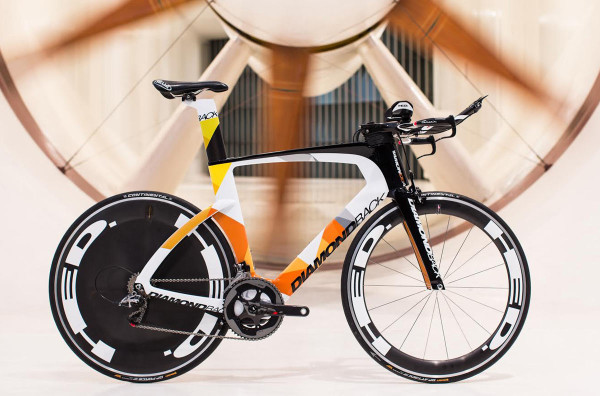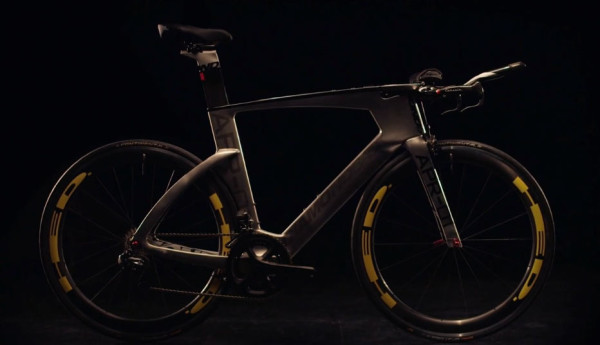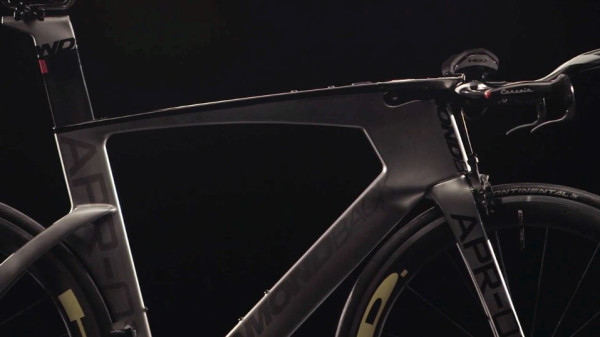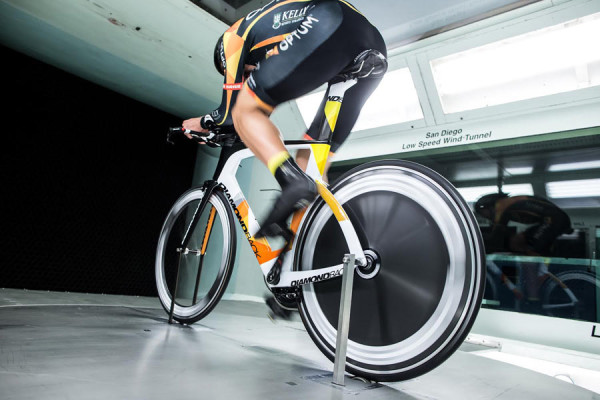Teased just before all the top triathletes headed to Kona for Ironman World Championships, the new Diamondback Serios slipped some very interesting frame shapes in and out of focus with a short video. Now, we’ve got a very in-focus look at one of the sharpest looking tri bikes in recent memory and some Q&A with DB’s product manager to make sense of it all.
The story is they started with thinner and thinner tubes, thinking a more waif-like structure would slice through the air quicker and easier. What they found was some cross sections could be wider and provide better aerodynamics. And wider was better when it came to the range of riders it could fit, too. The project is a collaboration between Diamondback, HED Cycling and Kevin Quan Studios. The result is a wild looking TT/Triathlon bike that’s UCI legal and fits pros and age groupers both short and tall.
Here’s how they did it…
Each of the partners brought their expertise to the table, which included Optum Pro Cycling Team rider feedback on the bike’s handling. HED’s engineers talked aerodynamics and bike fit, which is why you’ll see their wheels and cockpit used throughout the range. Quan’s design experience translated that data into a frame that not only looks good, but works from riders as short as 5’4″ and as tall as 6’5″, which happens to be the spread of Optum’s team riders.
As predicted, the stem and steerer design is heavily integrated into the frame, delivering smooth airflow across the front and all the through the frame. Senior Product Manager Michaal Brown explains the design:
“The headtube is the biggest beneficiary of increasing width. Making the headtube wider allows for the integrated stem to best package the shift and brake cables. There is no aerodynamic penalty because we then taper this wider headtube along the total length of the top tube. In effect, the top tube is simply the tail end of a very long headtube airfoil.
“Additionally, the wider headtube also allows us to package a tapered fork (1.375″ lower bearing) for increased front-end stiffness. This in turn means sharper handling and better stability on descents.”
The integrated design doesn’t sacrifice adjustability. The spacers are designed with the same air foil shape as the head tube and provide a smooth transition for any air passing over them. They work in the same way as any headset spacer, but they’re keyed and also function as the headset bearing cover. Bikes will ship with a set of 4 spacers (2x10mm and 2x15mm) and a steerer tube long enough to accommodate the full spacer stack. Once your properly fit to the bike, cut the steerer to the right length. Bikes will ship with a size-appropriate stem, but three lengths (95/105/115 mm) will be available for sale aftermarket.
But there’s more to the story of wider tubes:
“The wider sections are intrinsically more aerodynamic,” says Brown. “The drawback to reducing bicycle tubes to flat and narrow sections is that they will result in flow separation and higher drag in even the slightest of cross winds.
“In aerodynamics, there is a classic case called a Flat Plate scenario. Flat plates are not as aerodynamic as tear drop shaped airfoils in cross winds. So the question becomes when do bicycle sections begin to behave as flat plates and not airfoils? Diamondback has invested a lot of time and money into answering that question.”
For a bike that seemingly has so much aero tech designed into it, a fully exposed front brake seems out of place, but that, too, was intentional.
“There have been questions regarding the exposed front brake,” explains Brown. “We came to this decision after much internal debate. From past wind tunnel testing we have observed that exposed brakes contribute no additional drag than integrated brakes or even a fork with no brakes at all! It was Steve Hed that gave us the final piece of the puzzle when he observed that flow around the wheel at the fork crown was in fact reversed due to the direction of spin. We concluded that turbulence caused by the spinning front wheel in effect masks the presence of an exposed front brake.
With that being the case, we specified a Shimano direct mount brake which had demonstrated superior performance to both conventional center mount brakes and integrated v-brake alternatives.”
Regardless of which spec level you choose, you’re getting all the same design, tech and layup – all three share the same exact frameset.



